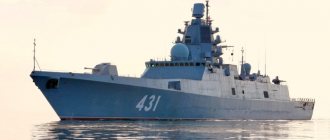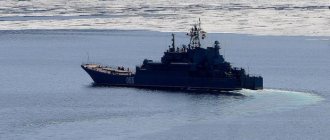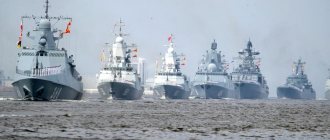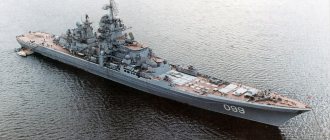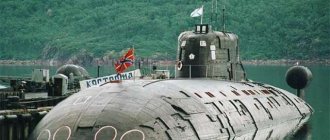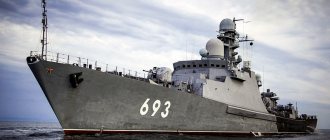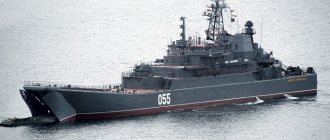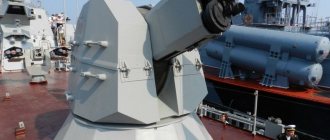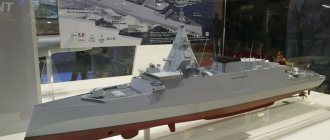The Russian navy is currently being re-equipped. Russia was forced to re-equip its fleet by insurmountable circumstances. The warships that Russia inherited from the Soviet Union have mostly fallen into disrepair. Of these, some of the old ones have been disposed of, and the other part must be modernized. They should be replaced by modern combat units - Project 22350 frigates.
Project 22350: why frigates?
Currently, the Russian naval forces have a sufficient number of small missile ships, as well as corvettes, which are required to guard Russian maritime borders. However, to further strengthen Russia’s naval power and to more reliably protect Russia’s sea approaches, vessels that guard the far sea zone are also needed. The Russian authorities, together with the Navy command, expect that this role will be played by frigates of the new Project 22350, designed to replace outdated missile cruisers.
Why frigates and not some other type of warship? A brief historical excursion is necessary here. There were no frigates in the naval forces of the USSR: in those days, combat ships were classified differently. Those that were essentially frigates were called patrol ships in the USSR or, in common parlance, “patrol ships.” These were reliable and formidable ships, capable of guarding the immediate approaches to the coast, as well as performing independent military missions in open waters. Subsequently, when the Russian Navy replaced the USSR Navy, patrol vessels began to be renamed frigates. In other words, combat vessels in Russia have become classified in the same way as throughout the world.
At the beginning of the new millennium, instead of outdated patrol ships, Russia began building a new generation of warships, that is, frigates. Russia was pushed to this by inevitable necessity. Old ships, such as the cruiser Grozny and the cruiser Admiral Golovko, were completely outdated and, accordingly, could not adequately carry out combat missions dictated by the times. The construction of new ships began to be referred to by the code name “Project 22350”. The result of the project should be the replacement of the outdated cruiser Admiral Golovko by a modern frigate of Project 22350.
According to the government’s plan, new Russian frigates are required to surpass the ships of previous generations in their combat qualities and, accordingly, strengthen the power of the Russian navy, regardless of what part of the world ocean such a ship will be located in. According to approximate tactical and technical characteristics, Project 22350 military vessels are designed for a cruising range in excess of 4,000 miles. In addition, they will be able to stay in the process of autonomous navigation for at least thirty days. Such characteristics will allow them to successfully protect the far sea zone. In terms of their displacement, as well as the variety of weapons, the new frigates will be to some extent inferior to the ships of the previous generation. However, the level of their security, electronic equipment, and fire control of frigates will be significantly higher.
Initially, the Russian government planned to equip all fleets, but subsequently government plans changed. It was decided to equip the Black Sea Fleet with new generation ships. For anyone who closely follows world political news, this decision of the Russian government is quite understandable.
Modern frigate for the Russian fleet
The appearance of a frigate in the Russian fleet as a class of combat vessels is not a new phenomenon. Since the era of the sailing fleet, ships of this class have had the greatest amount of work. Russian frigates carried out combat duty and reconnaissance on the near approaches to coastal facilities, and took part in battles as part of linear forces. With the beginning of the era of the steam fleet, frigates, as a class of warships, were forced into the shadows. Cruisers took their place. For almost 50 years, frigates disappeared from view. Only after the end of the Second World War did it again come the turn of these ships to appear on the vast oceans. The new ships have firmly found their niche in the combat composition of foreign fleets, taking their place in the combat formation between destroyers and cruisers.
In the Soviet Union, unlike the fleets of other countries, there were no ships of the frigate class, since the classification of ships by purpose was adopted. The functions of the frigate were performed by patrol ships. In terms of their functional qualities and combat equipment, Soviet patrol ships were full-fledged combat vessels, capable of not only operating in the coastal zone, but also performing a wide range of tasks at a considerable distance from their own bases. After the collapse of the USSR, a reform was carried out in the Russian Navy that affected the classification of combat ships. All large anti-submarine patrol ships in the fleet were reclassified as frigates.
Russia began building new ships of this type only in the new millennium, when the old guard in the form of former BODs and Grozny-class missile cruisers finally gave up their positions.
The new Project 22350 frigates being commissioned should fill the gap that arose after the decommissioning of the Project 58 missile cruiser Admiral Golovko. It was this ship that became the last representative of the class of combat ships, which in their tactical and technical characteristics were more reminiscent of frigates. Modern domestic frigates should become a powerful striking element of the fleet, strengthening with their presence the combat readiness of the Russian fleet anywhere in the world's oceans.
In accordance with their tactical and technical characteristics, Project 22350 ships must have a cruising range of more than 4 thousand miles and a navigation endurance of 30 days. In terms of displacement and armament, the new ships are slightly inferior to the Slava-class missile cruisers, surpassing the latter in the level of protection, electronic equipment and fire control. The naval leadership plans to create a new powerful core of the high seas fleet from the new Project 22350 frigates.
Initially, it was planned to strengthen all Russian fleets with new combat units. However, in the future it was decided to concentrate on equipping the Black Sea Fleet with new vessels.
Features of the construction of ships of project 22350
Exactly how many ships should be built to implement Project 22350 is unknown. However, some sources claim that at least twenty such ships should be built. The estimated time allotted for construction is no more than twenty years. It was planned to build the frigates at four enterprises: the Kaliningrad Shipyard, the Baltic Shipyard, the Shipbuilding Plant, and the Shipbuilding Plant, which are located in St. Petersburg.
On February 1, 2006, Severnaya Verf began building the first frigate of Project 22350, called Admiral Gorshkov. As befits the first-born, “Admiral Gorshkov” took a long time to incarnate, more than four years. There were several reasons for this: disputes over what the technical equipment of the ship should be, and the same disputes regarding its weapons.
On October 29, 2010, the first-born frigate “Admiral Gorshkov” solemnly launched into the water. The Russian Ministry of Defense made its final choice precisely at Severnaya Verf, and signed contracts with this plant involving the construction of seven more ships. Thus, it was the St. Petersburg shipbuilding plant that became the only enterprise that received the right to build Project 22350 ships.
The frigate "Admiral Gorshkov" is still not a full-fledged combat unit due to protracted testing. Construction of another ship called Admiral Kasatonov began in 2009, but it was launched only in mid-2015.
It is difficult to say about the reason for such slowness. The state, as well as shipbuilders, remain silent. Unlike forums, which, on the contrary, are full of all sorts of assumptions, versions and conjectures. In general, several basic assumptions are put forward on the forums to explain the slowness of domestic military shipbuilders. One version says that the Admiral Gorshkov had problems with the main engine turbine during testing. Replacing it with a new turbine turned out to be difficult, since such turbines were previously produced by one of the Ukrainian defense enterprises, which, due to well-known political events, refused to supply its products to Russia.
However, despite all sorts of problems and silence on the part of authorized authorities, the implementation of the project is proceeding as usual. In 2012, another frigate, Admiral Golovko, was laid down. After this, in 2013, they began to build the next ship, Admiral Isakov. Exactly when their construction will be completed has not yet been announced.
Russian frigates
PROJECT 22350 FRIGATES
, Admiral of the Fleet of the Soviet Union Gorshkov, was launched - the first Russian large warship designed, laid down and launched after the collapse of the USSR.
So Russia got involved in the race of modern naval weapons; after submarines of projects 955, 885 and 667 of various classes, surface ships began to appear. The shipbuilding program of the Russian Navy is gradually beginning to unwind - a sufficiently large number of ships and boats are already under construction and in plans to imagine the appearance of the Russian fleet in 10-20 years. For a long time, the Russian fleet has not been replenished with new surface ships of the main classes, including those designed and built in the 21st century. In addition to the Project 20380 Steregushchiy-class corvette, the Russian Navy will soon, in 2011, be strengthened by the first Russian-built Project 22350 frigate Admiral Gorshkov.
corvette “Steregushchy”
After a 15-year break, it became the first Russian ship in the far sea zone. Before this, ships of a similar purpose and class were built in the Soviet Union or already in the “new” Russian era, but only for a foreign customer (project 11356 for the Indian Navy). The important thing here is that this is a multi-purpose surface ship. It was simply not possible to place all the weapons necessary for such ships on the Project 20380 corvette. Even in Soviet times, repeated attempts were made to create a multi-purpose surface ship capable of solving such combat missions as air defense, combat against submarines and surface ships of a potential enemy. Back in the second half of the 1960s, the Northern Design Bureau completed project 61K of a multi-purpose ship (projects 61A and 61bis are also variants on this topic), later the same bureau carried out projects 11560 and 11990 “Anchar” (displacement up to 12,000 tons, air defense missile system “ Hurricane", RK "Oniks", PLRK "Vodopad") multi-purpose ships of the destroyer-cruiser class. At the end of the Project 956 series, it is planned to build a Project 11000 destroyer with a gas turbine installation, practically in the same hull, with an air defense system of the Uragan type, an anti-ship missile system "Oniks", a missile cruiser "Caliber", an anti-aircraft missile system, and a helicopter. But all of them remained projects that were not embodied in metal. Of those built, perhaps, the Admiral Chabanenko BOD of Project 11551 can be called a multi-purpose - universal ship, it has powerful means of detecting and combating submarines (anti-submarine missile systems, helicopters), the Moskit strike missile system, only air defense systems (Kinzhal air defense missile system ") turned out to be insufficient for the collective defense of a formation of ships, covering landing detachments and naval convoys from air raids.
BOD “Admiral Chebanenko”
But the cost of the issue turned out to be such that all the weapons were placed on a ship with a displacement of 9000 tons, one ship was built, and it appeared at the decline of the former power of the Russian Navy, and was supposed to continue the series of BODs of the “Udaloy” type of Project 1155. There is another one like this An example of the creation of a multi-purpose ship is the Project 11442 Frunze missile cruiser, here the issue of collective air defense is much better resolved - the S-300F air defense system with a firing range of up to 100 km. However, the ship’s displacement was already 24,000 tons; in fact, a “missile battleship” is the main caliber of the long-range Granit missile launcher. And it is clear that you cannot build many such ships; together with the lead Kirov of Project 1144, four cruisers were built.
ARKR “Admiral Nakhimov”
However, technological progress has borne fruit; missile weapons are being unified according to control and launch systems, the rate of fire of systems, their hit accuracy, and, as a result, efficiency are sharply increasing. At the beginning of the 21st century, promising missile systems of the “Caliber-NKE” type with 3M54E anti-ship missiles, 92RE anti-submarine missiles and 3M14E cruise missiles for firing at coastal targets, and the “Yakhont” type with supersonic anti-ship missiles appeared in Russia, in addition, universal launchers for their launch and unified ship control systems for these missile systems. In addition, there are now air defense systems of the “Rif-M” and “Shtil” types with very effective medium-range missiles (9M96 and 3M317ME, respectively) and rapid-fire vertical launch launchers. All this made it possible to create a Project 22350 frigate with a displacement of only 4,500 tons. Nowadays, you won’t surprise anyone with multi-purpose frigates and destroyers in the world, the Arleigh Bark cruisers were created in the USA, the EM Type 45 in England, multi-purpose frigates in other NATO countries, etc. .d. At the same time, as experts know, all modern NATO frigates and destroyers are equipped with the European version of the Aegis air defense system - the NAAWS type with the Mk41 air defense system for the Standard and ESSM missiles, or the PAAMS air defense system with the Aster missile system, also with a vertical launch, which in combined with the latest control systems for complexes and missiles, it can significantly expand the capabilities of the air defense systems themselves.
The frigate "Admiral of the Fleet of the Soviet Union Gorshkov" in the dock before launching
The frigate (large patrol ship) of Project 22350 was developed by the Northern Design Bureau (General Director V.I. Spiridopulo, General Designer V.E. Yukhnin, Chief Designer of the project - P.M. Shraiko), Chief Observer of the Navy - A.V. Yukhnin.
This is what the frigate will look like after construction
On February 1, 2006, the laying of the lead frigate “Admiral of the Fleet of the Soviet Union Gorshkov” according to project 22350 (Chief Builder – A.V. Ushakov) took place for the Russian Navy at Shipbuilding (General Director A.S. Buzakov). The Project 22350 frigate is designed to conduct combat operations in far and near sea zones, as well as to participate in solving problems in the ocean zone. The ship's displacement is approx. 4500 t, maximum length - about 130 m, maximum width - more than 16 m. Cruising range - more than 4000 miles, seaworthiness without restrictions. In addition to artillery and missile weapons, the ship is equipped with a helicopter base.
Launch of the frigate “Admiral of the Fleet of the Soviet Union Gorshkov”
The design of the ship has a “high percentage of novelty” - at least 30% new technologies and developments. In particular, some of the hull and superstructure elements will be made using stealth technology. The ship is so secret that even its appearance is known only to designers and shipbuilders.
at
universal ship complex UKSK
The launched Project 22350 frigate will carry a weapon system consisting of anti-ship cruise missiles, a 130-mm artillery mount, an anti-submarine missile system and a medium-range anti-aircraft missile system. The main strike system will be the new universal shipborne firing system 3S14U1 (UKSK). The use of the UKSK makes the warship multi-purpose, and its combat purpose can be changed at the base by simply replacing the ammunition with another type of missile. The new anti-aircraft missile system of the "Rif-M" type (sometimes referred to in the press as "Poliment-Redut") will be maximally unified with the Vityaz mobile land complex currently being developed. The ship has a new radar with four phased array antennas. As noted earlier, for small corvette-class patrol ships with a displacement from 1000 to 3000 tons MNIRE Altair, a promising small-sized system is being created, built on the basis of a reduced configuration of the Rif-M air defense system using only 9M96E type anti-aircraft missiles with an active homing head and an on-board inertial guidance system, which have the high dynamic characteristics necessary to intercept modern targets and a high probability of hitting air targets.
Currently, the ship is equipped with basic mechanical equipment and systems to ensure safe launching and completion afloat. Including a diesel-gas turbine unit, gear units, propeller shafts and propellers, mechanisms that provide electrical power. The technical readiness of the ship is 40 percent. The completion of the order will be carried out afloat. The lead frigate of Project 22350 should begin sea trials in the fall of 2011, and delivery to the fleet, according to the contract, should occur before the end of 2011. On November 26, 2009, Shipbuilding OJSC laid down the keel of the first serial frigate of Project 22350 “Admiral of the Fleet Kasatonov” (factory No. 922) for the Russian Navy. According to the general director of Severnaya Verf, Andrei Fomichev, “this will be a multi-purpose ship for the far sea zone.” Fomichev also noted that the launch of the frigate is planned in 2011, delivery - in 2012. It is expected that the lead ship "Admiral of the Fleet of the Soviet Union Gorshkov" will be accepted into the Baltic Fleet, and the entire Russian Navy is interested in purchasing it, according to various estimates from 10 to 30 ships of this project, which should become the main type of ship in the ocean zone. However, after the start of construction of new frigates, it became clear that updating the fleet with these complex and expensive ships risked being delayed, as a result of which it was decided to speed up the process by laying down, in parallel with the new frigates, a series of ships of Project 11356, already mastered by the domestic industry on export orders for India. In fact, simultaneously with the launch of the Project 22350 frigate, the export version of the newest Russian Project 22356 frigate was presented at the Euronaval-2010 exhibition. The Project 22356 multipurpose ship, designed at the Northern Design Bureau, is designed to solve a wide range of tasks in the ocean zone.
Project 22356 frigate with Shtil-1 air defense system at Euronaval-2010
The frigate's displacement is 4550 tons, length 135.0 m, width 16.4 m, draft 4.4 m. The combined diesel-electric main power plant provides the ship with a full speed of 29.5 knots, a cruising range at an economic speed of 4500 miles, autonomy - 30 days. The frigate's main strike armament is the integrated Kalibr-NKE missile system and a complex with Yakhont anti-ship missiles (up to 16 3M-54TE, 3M-54TE1, 3M-14TE or Yakhont missiles). The defense of the ship from enemy air will be provided by the Rif-M (32 missiles) or Shtil-1 (36 missiles) air defense systems. Artillery armament is represented by one 130-mm artillery mount, two 30-mm firing modules of the close-range air defense complex, as well as two heavy machine guns on pedestal mounts.
Anti-aircraft missile 9M317ME
For 9M317ME missiles, the Ekaterinburg Research and Production Enterprise Start has created a modular launcher 3S90E.1, which consists of three launch modules (each for 12 missiles in transport and launch containers).
Despite the fact that it is probably premature to talk about large ships of the Russian Navy today, it should be noted that on the basis of the Rif-M air defense system, which became a more advanced modification of the S-300F complex (a ship version of the “land” S-300P), MNIRE Altair is developing an integrated anti-aircraft fire system designed for installation on ships of the cruiser and destroyer classes. This complex is designed to protect orders of ships and their formations from simultaneous attacks by modern and promising air attack weapons. It provides simultaneous shelling of up to 6-8 targets and guidance of 12-16 missiles at them at a range of up to 120 km.
The fight against underwater enemies is ensured by up to 8 PLO 91RTE2 missiles (by reducing the ammunition capacity of strike missiles of the Kalibr-NKE complex), as well as the small-sized torpedo anti-submarine complex Paket-E/NK.
Project 22356 frigate with Rif-M air defense system
Radio-technical weapons are represented by the Fregat-M2EM air and surface target detection radar, the Mineral-ME long-range surface illumination radar, the Zarya-ME-03 sonar system, the Vignette-EM sonar system, and the MTK optical-electronic situation lighting system. -201ME. The integrated operation of all combat and radio-electronic equipment of the ship is ensured by the Sigma-E22356 BIUS.
Optical-electronic situation lighting complex MTK-201ME
Electronic reconnaissance and suppression equipment is represented by the TK-25E REP and KT-308-05 projectile jammer systems. The ship provides permanent deployment of one Ka-28 helicopter. Following the frigates should come the turn of ships of the first rank. It is already known that work on the creation of a new generation destroyer project is being completed in Russia. This ship, with a displacement of about 10,000 tons, is also expected to be equipped with universal launchers common to the entire surface fleet, a standard combat information and control system and other standardized equipment. This trio - a corvette, a frigate, a destroyer of a new generation should form the basis of the power of the surface fleet in the next 20-30 years.
Proposal for Project 21956 export destroyer
On February 1, 2012, at Sudostroitelny in St. Petersburg, a solemn ceremony of laying down the new frigate “Admiral Golovko” (of the “Admiral Gorshkov” type) of Project 22350 and the first head corvette “Gremyashchiy” of Project 20385 for the Russian Navy took place. An official representative of the Navy reported this to ITAR-TASS. “The uniqueness of the event is that two surface combat ships are laid down on the same day,” he emphasized. As a representative of the fleet noted, the Navy plans to build and commission a series of frigate-class surface ships and corvette-class ships. “This will allow us to effectively carry out missions in far and near sea zones,” he said. The construction of such frigates is provided for in the weapons program for 2011-2020. During this period, it is expected to deliver 10 ships to the customer. The main weapon of the Project 22350 ship will be the Caliber missile system with a universal 16-container vertical launcher (UVPU) 3S-14 with the ability to deploy sea-based cruise missiles, anti-ship missiles and anti-submarine guided missiles. The ship's air defense will be provided by the Poliment-Redut air defense system and the Kortik anti-aircraft missile and artillery system. The Poliment-Redut air defense system has one 32-round vertical launcher, and the Kortik air defense system consists of two combat modules (2x4 missile launchers with ammunition of 32 missiles and 2x6 30-mm automatic cannons). The ship's artillery is represented by one A-192 automatic cannon. The ship will also be equipped with a Ka-27 deck helicopter. (ITAR-TASS) The frigate of project 22350 “Admiral Kasatonov” will be transferred to the Russian Navy in 2014, the lead ship of this project “Admiral Gorshkov” - in 2012, Commander-in-Chief of the Russian Navy Admiral Vladimir Vysotsky said on Wednesday in St. Petersburg. "Admiral Kasatonov" is a ship of 2014. We hope that the lead ship “Admiral Gorshkov” will be handed over to the fleet this year,” the commander-in-chief noted. According to him, it can definitely be said that this year the ship will enter state tests. He emphasized that currently there are certain problems associated with the adoption of this ship. “However, they are not systematic in nature, so we hope that the ship will be put into service in 2012,” Vysotsky said. He emphasized that he plans to transfer the first three frigates of this type to the Northern Fleet, since they are ships in the far sea zone. “However, this is my personal opinion; the final decision on sending ships to the fleet will be made later,” the commander-in-chief said. He also said that a lot of work is currently underway to design a promising destroyer. According to the commander-in-chief, the displacement of this ship will be twice that of currently existing US Navy cruisers. It will have a completely different power plant, Vysotsky said. Previously, he reported that destroyer-type ships can be equipped with a nuclear power plant. The Commander-in-Chief noted that ships of this type are very complex projects that require a lot of work in design bureaus and large financial investments in the future. “That’s a prospect we’re working on now,” he said.
The first large ship of the Navy made of carbon fiber will begin sea trials in the Barents Sea no later than the end of November, this is the frigate Admiral Gorshkov, the lead ship of Project 22350, a source in the Navy High Command told Izvestia that upon completion of the tests the ship will join the 14th brigade anti-submarine ships of the Northern Fleet, the frigate was created using stealth technology: the entire external superstructure consists of composite materials that absorb or partially conduct radio waves through themselves, and this ensures invisibility from radars. Opinions on the ship were divided. Navy officers say carbon fiber is unsuitable because it is weak compared to ship steel, and they doubt that the superstructure will not collapse in the climate of the North, where there are strong winds, low temperatures and frequent storms. In addition, when launching anti-ship and anti-aircraft missiles, the superstructure is exposed to strong thermal effects. At Severnaya Verf they believe, on the contrary, that carbon fiber is superior to steel in physical parameters. They explained to Izvestia that the tests carried out on the superstructure and its individual elements showed high strength and resistance to temperature influences. "Gorshkov" was the first to receive not only the stealth superstructure, but also the latest diesel-gas turbine propulsion system. It is economical and provides better overclocking characteristics. The frigate also has a lot of modern electronics, which are not found on existing ships. This is its strength and at the same time weakness, since there are no trained specialists. A representative of the Navy High Command and a number of Northern Fleet officers say that it is impossible to form a crew without lengthy training on land. The lead frigate of Project 22350 "Admiral Gorshkov", which is being completed in St. Petersburg at the shipbuilding plant, will be equipped with the latest Poliment-Rudut air defense system before factory sea trials, a Navy representative told Interfax. “The first exit of the Admiral Gorshkov for factory sea trials is scheduled for early October. In the Gulf of Finland, the frigate will test the main power plant, navigation equipment and communications complex. Then the ship will move to Baltiysk. In the Barents Sea, “Gorshkov” will test launches from its anti-ship, anti-submarine and anti-aircraft systems,” the agency’s interlocutor said. According to a Navy representative, before sea trials, vertical launch cells for the Poliment-Redut air defense system with 128 9M96E anti-aircraft missiles must be installed on the ship. The Navy representative recalled that the ship was inhabited by a crew in April, mooring tests of the ship began in May, and state tests should take place before the end of December. In addition, “Admiral Gorshkov” will be presented at the International Naval Show in St. Petersburg on July 3. The multi-purpose frigate of Project 22350 is designed to conduct combat operations in the far and near sea zones, as well as to participate in solving problems in the ocean zone. The ship's displacement is about 4,500 tons, its maximum length is about 130 m, and its maximum width is more than 16 m. Cruising range - more than 4000 miles, seaworthiness - without restrictions. The ships of the project are armed with 16 missiles of the Oniks anti-ship complex of the Kalibr-NKE family. The frigates of the project will be equipped with 4 modules of the Poliment-Redut air defense system, 8 cells each (32 cells in total). The frigate was developed by the Northern Design Bureau. Its cost is up to 400 million dollars. In accordance with the concluded contracts, Severnaya Verf must build and deliver to the Navy 6 frigates of Project 22350 by 2022. Military-industrial courier Anti-aircraft missile complex-REDUT (REDUT)
Modern warships of the Russian Navy are so far equipped with Ukrainian power plants produced by the state enterprise Research and Production Gas Turbine Engineering Complex (GP NPKG) ZORYA-MASHPROEKT, which is located in Nikolaev. As Anatoly Stashok, deputy head of the marketing department of ZORYA-MASHPROEKT, told the ARMS-TASS correspondent at the “Innovation Day of the Russian Ministry of Defense”, the enterprise is fulfilling a series of contracts for the supply of main power plants (GPU) for the newest Russian frigates of the Admiral Gorshkov type ( project 22350) and frigates of project 11356. Two M56 units with a capacity of 60 thousand hp were manufactured and delivered to the shipbuilding plant through the Russian one. for the new Russian frigates of Project 22350 “Admiral Gorshkov” and “Admiral Kasatonov”. The production of the installation for the third frigate of this project, Admiral Golovko, is being completed. As for the power plant for Project 22350 frigates, it is produced jointly by Ukraine and Russia, since Russian enterprises are at the stage of mastering its production. ZORYA-MASHPROEKT produces, in particular, only the gas generator and gearbox of this installation, while Russian enterprises manufacture the turbine and automatic control system. As NPO Saturn reported, in the future, new ships of the Russian Navy and the FSB Border Guard Service are expected to be equipped with new generation power plants only of domestic production, developed by Rybinsk engine builders.
ON NOVEMBER 14, 2013, A NEW FRIGATE AND THE FIRST SERIAL RECOVERY VICTOR WILL BE LAYED AT THE NORTHERN SHIPYARD On November 14, 2013, on the day of the celebration of the 101st anniversary of the creation of JSC Severnaya Verf, the enterprise will lay down two ships: the 3rd serial frigate of Project 22350 “Admiral” Fleet of the Soviet Union Isakov" and the first serial medium reconnaissance ship of Project 18280 "Ivan Khurs" for the Russian Navy. Currently, the lead ship of Project 22350 “Admiral of the Fleet of the Soviet Union Gorshkov” (the designer of the vessel is the Federal State Unitary Enterprise “Northern Design Bureau”) is undergoing mooring tests, and the first and second production frigates of this project “Admiral of the Fleet Kasatonov” and “Admiral of the Fleet Golovko” are being built on schedule on the slipways; a contract has been signed with the Ministry of Defense for the construction of 6 frigates of this series. In general, over the next 15-20 years, the Russian Navy's need for ships of this type will amount to up to 20 units. The ship is named in honor of Admiral of the Fleet of the Soviet Union Ivan Stepanovich Isakov (08/22/1894 - 10/11/1967), who held senior command positions in the Main Command of the USSR Navy and made an outstanding contribution to the construction and development of the country's navy.
The medium reconnaissance ship "Ivan Khurs" (the designer of the vessel is JSC Central Design Bureau "Iceberg") is the first production ship of this project for the Russian Navy, which will significantly surpass similar ships of previous generations in its tactical and technical characteristics.
“Ivan Hurst”
The lead communications vessel “Yuri Ivanov” was launched at Severnaya Verf OJSC on September 30, 2013.
descent of “Yuri Ivanov”
Project 18280 reconnaissance ships have high seaworthiness, a high level of automation and systems integration. These ships are capable of solving the widest range of tasks assigned by the command. Compared to their predecessors, Project 18280 communication vessels have significantly improved the efficiency and operational characteristics of ship power, and introduced extensive automation of control processes for communication and radio surveillance systems and ship technical equipment. The communications vessel is named in honor of Vice Admiral Ivan Kuzmich Khurs (09/29/1922 - 12/28/2002), who made an outstanding contribution to the creation and development of permanent Navy intelligence.
REFERENCE:
Isakov Ivan Stepanovich, born 22.08. 1894 in the village. Adjikend, located on the territory of modern Azerbaijan. At the age of 20 he began his naval service. During the First World War he served as a midshipman on the destroyer Izyaslav. After the October Revolution, he commanded ships in the Baltic and Black Seas, held staff positions, and taught at the military academy. In 1937-1938 commander of the Baltic Fleet. In 1938–1950, deputy (from 1939 1st deputy) People's Commissar of the Navy; in 1941–1943 and 1946–1950, Chief of the Main Naval Staff, then Deputy Commander-in-Chief of the Navy, Deputy Minister of the Navy. Since 1945 - Admiral of the Fleet. Author of historical and fictional works, editor of the Maritime Atlas, laureate of the Stalin Prize (1951), corresponding member of the USSR Academy of Sciences (1958), member of the Union of Writers of the USSR (1964). Decree of the Presidium of the Supreme Soviet of the USSR dated May 7, 1965 “for skillful leadership of troops, courage, bravery and heroism shown in the fight against the Nazi invaders, and in commemoration of the 20th anniversary of the Victory of the Soviet people in the Great Patriotic War” to Admiral of the Fleet of the Soviet Union Isakov Ivan Stepanovich was awarded the title of Hero of the Soviet Union.
Main performance characteristics of the frigate
Displacement - 3900/4500 t, Main dimensions, m: length - 130-135, Width - 16, Draft - 4.5, Power plant - Diesel-gas turbine power plant, power - 65,000 l. With. (total), 2 diesel engines 10D49 with a power of 5200 hp each. s., M90FR gas turbine engine with a capacity of 27,500 l. s., Full speed, knots. – 29, Cruising range, miles (kts) – 4000 (14 kts), Endurance, days – 30, Number of shafts – 2, Propeller type – fixed propeller, Crew, persons. - 180-210, Armament: Missile - UKSK: 2x8, SAM - 4x8 SAM "Redut", AU - 130mm (A-192), SAM - 2 BM "Broadsword", PLUR - 2x4 "Medvedka-2", AB - 1 Ka-28 helicopter.
| Project representativesTitle | Airborne number | Manufacturer | Serial number | Bookmark date | Launching | Commissioning |
| Admiral of the Fleet of the Soviet Union Gorshkov | 417 | Northern Shipyard (St. Petersburg) | 921 | February 1, 2006 | October 29, 2010 | 2013 (plan) |
| Fleet Admiral Kasatonov | Northern Shipyard (St. Petersburg) | 922 | November 26, 2009 | summer 2013 (forecast) | November 2014 (plan) | |
| Admiral Golovko | Northern Shipyard (St. Petersburg) | 923 | February 1, 2012 | 2014 | 2015 | |
| Admiral of the Fleet of the Soviet Union Isakov | Northern Shipyard (St. Petersburg) | 924 | November 14, 2013 | |||
| Admiral Yumashev | Northern Shipyard (St. Petersburg) | 2013 (plan) |
Text and photo by A.V. Karpenko
Tactical and technical characteristics of frigates of project 22350
For obvious reasons, most of these characteristics are unknown to the general public, and should not be known. However, many people are familiar with some general characteristics of the ships under construction from the new series:
- The hull is equipped with side stabilizers, the rudders of which will not be retracted. This device is necessary to ensure that the ship does not lose its performance during a storm;
- The superstructures will be made of special materials with composite characteristics. Such materials help reduce the radio-acoustic background of ships;
- The frigates will be equipped with Stealth technology. This technology makes ships stealthy, preventing enemy radars from detecting them;
- All will have a double bottom, which will help the ships stay afloat if damage occurs;
- A universal fire extinguishing system will be installed;
- The power of the propulsion system will reach 55 thousand horsepower;
- The maximum speed will reach 29 knots;
- Using economic propulsion (14 knots), the frigate will be able to travel 4,000 miles without stopping.
Most likely, when testing new ships, some of their initial characteristics will change.
Estimated armament of Project 22350 ships
The new ships are planned to be equipped with the most modern weapons:
- The most powerful armament of the frigates is expected to be the 16 Moskit anti-ship missile launcher;
- In addition, the vessels will be equipped with the A-192 universal automatic artillery mount;
- To destroy enemy submarines, the ships will be armed with Medvedka-2 anti-submarine systems;
- To assess the hydroacoustic underwater space, frigates are equipped with a special Vignette-M system. This system allows you to hear an enemy submarine at a distance of up to 60 kilometers;
- To protect themselves from air attack, they will use the Redut anti-aircraft missile system;
- For the same purpose, as well as for hitting unobtrusive targets on the surface of the water, they will be equipped with the Broadsword missile and gun system;
- All ships of this project must also have Ka-27 helicopters with the ability to take off and land on deck.
Again, it is quite obvious that in the future the ships’ armament can be supplemented or changed.
The best ship of the Northern Fleet
On July 26, 2022, the State Commission, chaired by Captain 1st Rank Viktor Ivanov, signed an acceptance certificate for state testing of the frigate. Two days later, the St. Andrew's flag was raised on the frigate. “Admiral of the Fleet of the Soviet Union Gorshkov” was included in the 43rd division of missile ships of the Northern Fleet of the Russian Navy.
On October 4, 2022, the Department of Information and Mass Communications of the Ministry of Defense of the Russian Federation reported that the frigate "Admiral of the Fleet of the Soviet Union Gorshkov", carrying out the planned tasks of a combat training course in the Barents Sea, successfully conducted a series of practical firing at sea and air targets from a naval anti-aircraft missile system basing the vertical launch "Poliment-Redut". The ship's crew successfully hit aerial targets at various altitudes and distances with anti-aircraft missiles three times. An accurate hit was also noted on a sea shield simulating a small surface target.
From February 26 to August 19, 2022, the frigate made the first long-distance sea voyage in its history - a circumnavigation of 35 thousand nautical miles, during which the Suez and Panama Canals were passed, the equator was crossed in two oceans.
Based on the results of combat training, the frigate was recognized as the best ship of the Northern Fleet in 2022.
There, beyond the fogs... Naval sailors should not have problems, but tasks Read more
How will Project 22350 perform in the near future?
Only the Russian government and shipbuilders can answer how successfully the project is being implemented. The latest news claims that this year only one Admiral Gorshkov has been brought to full readiness. The long time it took to test it was dictated by practical considerations. The ship carried out thorough testing of the types of weapons that future ships would be equipped with. In addition to the weapons, the tactical and technical data of the ship itself were also carefully checked in order to prevent identified deficiencies on those frigates that are expected to be built in the near future.
The Admiral Golovko frigate, the second to be laid down, is expected to be ready by early 2022. As for the frigate "Admiral Isakov", nothing is said about the specific date of its construction. It is even more unknown when construction of other vessels of this project will begin.
Of course, building ships is a long process. However, such a duration may mean that by the time it is built, some of the innovations that are planned may become outdated, and then the newly built ship will have to be improved in accordance with the latest advances in technology, electronics and weapons. In any case, many experts fear this. The shipbuilders themselves object to them in the sense that frigates are built with a solid foundation, and therefore there is no reason to fear that they will be outdated by the time they are built.
There is some merit to such objections. At the moment, Russian frigates of Project 22350 can be considered the most modern in the world, both in terms of technological features and in terms of aesthetics and design. Their weapons are also at the highest level. In any case, there are no ships similar to the new Russian frigates in any foreign fleet yet.
